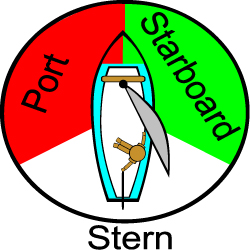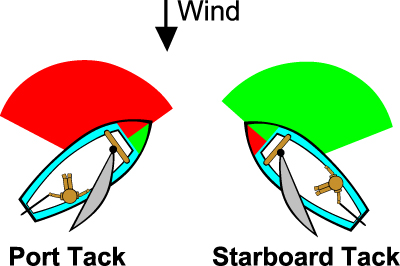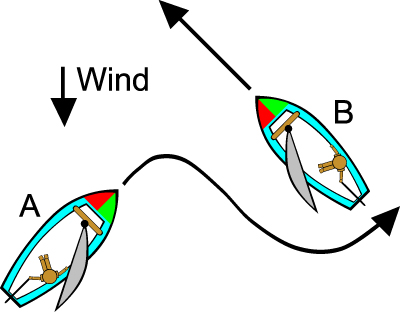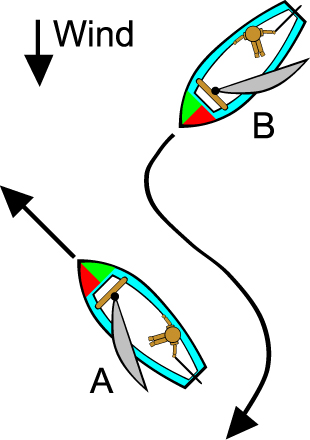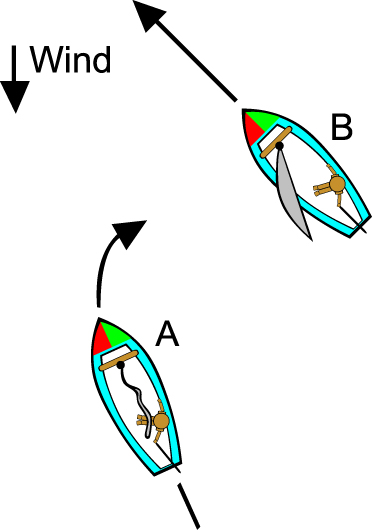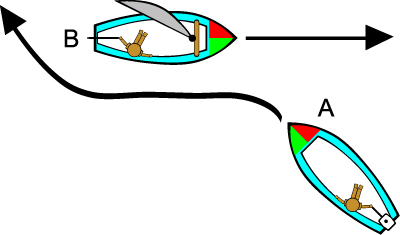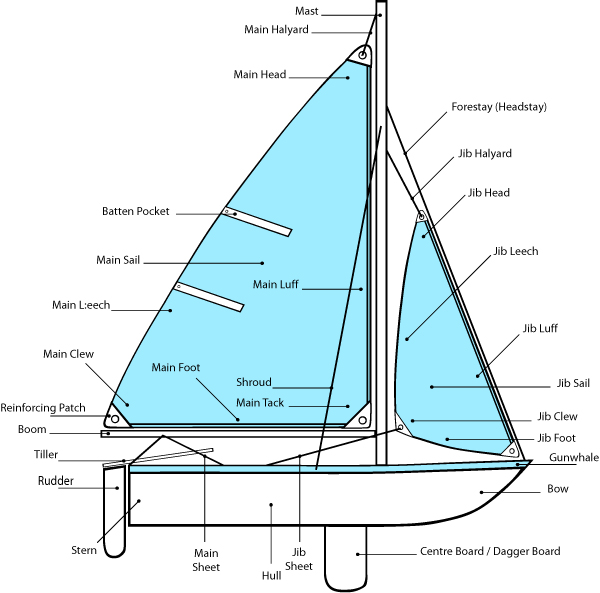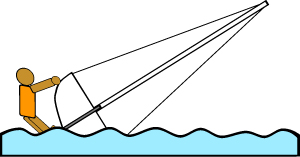Difference between revisions of "AY Honors/Sailing/Answer Key"
m (spelling, punctuation) |
|||
| (9 intermediate revisions by the same user not shown) | |||
| Line 1: | Line 1: | ||
{{honor_header|2|1953|Recreation<br>General Conference<br>2001 Edition}} | {{honor_header|2|1953|Recreation<br>General Conference<br>2001 Edition}} | ||
| − | == Have the Intermediate Swimming Honor.== | + | == 1. Have the Intermediate Swimming Honor.== |
Answers to the [[Adventist Youth Honors Answer Book/Recreation/Swimming - Intermediate|Intermediate Swimming]] honor can be found in the [[Adventist Youth Honors Answer Book/Recreation|Recreation]] chapter of this wikibook. | Answers to the [[Adventist Youth Honors Answer Book/Recreation/Swimming - Intermediate|Intermediate Swimming]] honor can be found in the [[Adventist Youth Honors Answer Book/Recreation|Recreation]] chapter of this wikibook. | ||
| − | == Know the "rules of the road" for boating.== | + | == 2. Know the "rules of the road" for boating.== |
| − | |||
| − | == Know how weather conditions and high wave conditions can affect safety and sailing performance.== | + | For the purposes of the sailing honour we will focus in the rules of the road that apply to small sailing boats. |
| − | == What safety precautions should be followed when sailing? == | + | |
| − | == With the help of a friend, do the following.== | + | It is important to note here that you are responsible for learning the rules and regulations that apply to whichever boat you are operating in the country and state or province where you are operating the boat. |
| + | |||
| + | There are '''five''' basic rules of the road for small sailing boats to decide who has the "Right-of-Way" so that each boat's skipper (driver) will know what to do to avoid a collision. | ||
| + | |||
| + | When sailing the words "left" and "right" in reference are replaced with "port" and "starboard". It is important to remember which is which since the rules of the road for sailing rely on using these words to assign right-of-way. | ||
| + | |||
| + | |||
| + | [[Image:Sail-Port-Starboard.jpg]] | ||
| + | |||
| + | You might be able to remember this by noticing that the letter "R" appears twice in the word "starboard", and only once in "port". Then since "right" begins with "R", you will know that the right hand side of the boat when facing forward is the starboard side. | ||
| + | |||
| + | The next item to remember is the word "tack" and how it is used to describe which side of the boat the wind is blowing from. As seen in the illustration below, if the wind is coming from the right hand side of the boat, and the sail is on the left side, the boat is on a starboard tack. When the wind and sail are reveresed, the boat is on a port tack. | ||
| + | |||
| + | |||
| + | [[image:Sail-Tacks.jpg]] | ||
| + | |||
| + | === Rule Number 1: === | ||
| + | |||
| + | When two sailboats are approaching each other and are on different tacks, the boat on the starboard tack has the right-of-way over the boat which is in the port tack. | ||
| + | |||
| + | In the illustration below, boat "A" on the port tack, must turn to avoid boat "B" on the starboard tack. | ||
| + | |||
| + | [[Image:Sail-Different-Tack.jpg]] | ||
| + | |||
| + | === Rule Number 2: === | ||
| + | |||
| + | When two sailboats are approaching each other and are on the same tack, the leeward boat has the right-of-way over the windward boat. Another way to say this is to say that the boat closer to the wind source must keep clear. The boat further from the wind source has the right-of-way. | ||
| + | |||
| + | In the illustration below, boat "B" is the windward boat and must turn to avoid boat "A" which is leeward. | ||
| + | |||
| + | [[Image:Sail-Same-Tack.jpg]] | ||
| + | |||
| + | === Rule Number 3 === | ||
| + | |||
| + | A sailboat that is staying on a tack has the right-of-way over a sailboat that is tacking or jibing. A simpler way to say this is to say "make sure you have room to complete a tack or a jibe without interfering with any other boats before doing so". Make sure that you can see clearly in all directions to ensure you have room. | ||
| + | |||
| + | In the illustration below, boat "A" must ensure that it leaves plenty of room to avoid boat "B", who has the right-of-way, since boat "B" is continuing on its tack. | ||
| + | |||
| + | [[Image:Sail-Tack-Jibe.jpg]] | ||
| + | |||
| + | === Rule Number 4 === | ||
| + | |||
| + | Any sailboat that is overtaking a slower boat from behind must steer clear of the slower boat and give right-of-way. The slower boat should hold its course and allow the faster boat to pass. | ||
| + | |||
| + | In the illustration below, boat "A" is a faster boat, and must steer around the slower boat "B", who should remain on the same course. | ||
| + | |||
| + | |||
| + | [[Image:Sail-Overtake.jpg]] | ||
| + | |||
| + | |||
| + | === Rule Number 5 === | ||
| + | |||
| + | Most of the time sailboats have the right-of-way over power boats. Since most powerboats are more easily maneuverable that sailboats, they must steer clear. This is not always the case however. Larger power boats are sometimes steering in the deep channel of the area, and cannot leave the channel. In this case the sailboat does not have right-of-way, and must avoid impeding the progress of the larger vessel. Many larger power boats cannot simply stop quickly or easily turn to avoid a small sailboat, so it is in the sailor's best interest to steer well clear of these larger boats. | ||
| + | |||
| + | In the illustration below, the powerboat "A" must turn to avoid the sailboat "B", who has the right-of-way. | ||
| + | |||
| + | [[Image:Sail-Power.jpg]] | ||
| + | |||
| + | == 3. Know how weather conditions and high wave conditions can affect safety and sailing performance.== | ||
| + | == 4. What safety precautions should be followed when sailing? == | ||
| + | == 5. With the help of a friend, do the following.== | ||
=== Get a sailboat underway from a dock, mooring, or beach. === | === Get a sailboat underway from a dock, mooring, or beach. === | ||
| − | === Properly adjust sails for the following conditions: === | + | === Properly adjust sails for the following conditions:<br>Beating the wind<br>Beam reach<br>Broad reach<br>Close reach<br>Downwind=== |
| − | + | ;Beating the wind: | |
| − | + | ;Beam reach: | |
| − | + | ;Broad reach: | |
| − | + | ;Close reach: | |
| − | + | ;Downwind: | |
| − | |||
=== Change tack by coming about and by jibing. === | === Change tack by coming about and by jibing. === | ||
=== Return the sailboat to a dock, mooring, or beach, and prepare it for being unattended.=== | === Return the sailboat to a dock, mooring, or beach, and prepare it for being unattended.=== | ||
| − | == Know how to tie and use the following knots in sailing: == | + | == 6. Know how to tie and use the following knots in sailing: == |
=== Square knot. === | === Square knot. === | ||
{{Knot_square}} | {{Knot_square}} | ||
| Line 40: | Line 98: | ||
{{Knot_mooring_hitch}} | {{Knot_mooring_hitch}} | ||
| − | == List ways to care for your sailing equipment throughout the year. == | + | == 7. List ways to care for your sailing equipment throughout the year. == |
| − | == Have a knowledge of at least 20 terms used in sailing and their meanings. == | + | == 8. Have a knowledge of at least 20 terms used in sailing and their meanings. == |
| − | == Identify at least 15 parts of a sailboat. == | + | == 9. Identify at least 15 parts of a sailboat. == |
The names of the parts of a sailboat can be broken down into three sets of terms: | The names of the parts of a sailboat can be broken down into three sets of terms: | ||
* Parts of the sail | * Parts of the sail | ||
| Line 164: | Line 222: | ||
[[Image:Parts of sailboat.jpg]] | [[Image:Parts of sailboat.jpg]] | ||
| − | == Demonstrate the rescue of a person overboard. == | + | == 10. Demonstrate the rescue of a person overboard. == |
| − | Note: This requirement should be done under the supervision of an adult, with a rescue boat, to give assistance if needed. | + | '''Note: This requirement should be done under the supervision of an adult, with a rescue boat, to give assistance if needed.''' |
| − | == Demonstrate what to do when a sailboat capsizes. == | + | == 11. Demonstrate what to do when a sailboat capsizes. == |
| − | Note: This requirement should be done under the supervision of an adult, with a rescue boat, to give assistance if needed. | + | '''Note: This requirement should be done under the supervision of an adult, with a rescue boat, to give assistance if needed.''' |
Capsizing is when your boat turns over (some say when the mast is in the water). A capsized boat may be either floating with the mast and sail lying on the water, or may have "turned turtle" lying with the mast pointing downwards. Some sailing schools tie a tether ball or flotation item to the top of the mast, so if a student capsizes the boat cannot turn turle. This is a good idea for beginner sailors. | Capsizing is when your boat turns over (some say when the mast is in the water). A capsized boat may be either floating with the mast and sail lying on the water, or may have "turned turtle" lying with the mast pointing downwards. Some sailing schools tie a tether ball or flotation item to the top of the mast, so if a student capsizes the boat cannot turn turle. This is a good idea for beginner sailors. | ||
Revision as of 01:00, 3 January 2007
1. Have the Intermediate Swimming Honor.
Answers to the Intermediate Swimming honor can be found in the Recreation chapter of this wikibook.
2. Know the "rules of the road" for boating.
For the purposes of the sailing honour we will focus in the rules of the road that apply to small sailing boats.
It is important to note here that you are responsible for learning the rules and regulations that apply to whichever boat you are operating in the country and state or province where you are operating the boat.
There are five basic rules of the road for small sailing boats to decide who has the "Right-of-Way" so that each boat's skipper (driver) will know what to do to avoid a collision.
When sailing the words "left" and "right" in reference are replaced with "port" and "starboard". It is important to remember which is which since the rules of the road for sailing rely on using these words to assign right-of-way.
You might be able to remember this by noticing that the letter "R" appears twice in the word "starboard", and only once in "port". Then since "right" begins with "R", you will know that the right hand side of the boat when facing forward is the starboard side.
The next item to remember is the word "tack" and how it is used to describe which side of the boat the wind is blowing from. As seen in the illustration below, if the wind is coming from the right hand side of the boat, and the sail is on the left side, the boat is on a starboard tack. When the wind and sail are reveresed, the boat is on a port tack.
Rule Number 1:
When two sailboats are approaching each other and are on different tacks, the boat on the starboard tack has the right-of-way over the boat which is in the port tack.
In the illustration below, boat "A" on the port tack, must turn to avoid boat "B" on the starboard tack.
Rule Number 2:
When two sailboats are approaching each other and are on the same tack, the leeward boat has the right-of-way over the windward boat. Another way to say this is to say that the boat closer to the wind source must keep clear. The boat further from the wind source has the right-of-way.
In the illustration below, boat "B" is the windward boat and must turn to avoid boat "A" which is leeward.
Rule Number 3
A sailboat that is staying on a tack has the right-of-way over a sailboat that is tacking or jibing. A simpler way to say this is to say "make sure you have room to complete a tack or a jibe without interfering with any other boats before doing so". Make sure that you can see clearly in all directions to ensure you have room.
In the illustration below, boat "A" must ensure that it leaves plenty of room to avoid boat "B", who has the right-of-way, since boat "B" is continuing on its tack.
Rule Number 4
Any sailboat that is overtaking a slower boat from behind must steer clear of the slower boat and give right-of-way. The slower boat should hold its course and allow the faster boat to pass.
In the illustration below, boat "A" is a faster boat, and must steer around the slower boat "B", who should remain on the same course.
Rule Number 5
Most of the time sailboats have the right-of-way over power boats. Since most powerboats are more easily maneuverable that sailboats, they must steer clear. This is not always the case however. Larger power boats are sometimes steering in the deep channel of the area, and cannot leave the channel. In this case the sailboat does not have right-of-way, and must avoid impeding the progress of the larger vessel. Many larger power boats cannot simply stop quickly or easily turn to avoid a small sailboat, so it is in the sailor's best interest to steer well clear of these larger boats.
In the illustration below, the powerboat "A" must turn to avoid the sailboat "B", who has the right-of-way.
3. Know how weather conditions and high wave conditions can affect safety and sailing performance.
4. What safety precautions should be followed when sailing?
5. With the help of a friend, do the following.
Get a sailboat underway from a dock, mooring, or beach.
Properly adjust sails for the following conditions:
Beating the wind
Beam reach
Broad reach
Close reach
Downwind
- Beating the wind
- Beam reach
- Broad reach
- Close reach
- Downwind
Change tack by coming about and by jibing.
Return the sailboat to a dock, mooring, or beach, and prepare it for being unattended.
6. Know how to tie and use the following knots in sailing:
Square knot.
Bowline.
Clove hitch.
Figure-eight.
Two half-hitches.
Template:Knot two half hitches
Mooring hitch.
7. List ways to care for your sailing equipment throughout the year.
8. Have a knowledge of at least 20 terms used in sailing and their meanings.
9. Identify at least 15 parts of a sailboat.
The names of the parts of a sailboat can be broken down into three sets of terms:
- Parts of the sail
- Parts of the rigging
- Parts of the boat
Parts of the sail.
- Battens
- Plastic or wooden slats inserted in the leech of the mainsail to help stabilize back edge.
- Clew
- The lower aft corner of the mainsail. The clew is located where the leech and the foot intersect.
- Cringle
- A grommet or metal ring in a sail though which a line is usually attached.
- Foot
- The bottom edge of a sail. The foot of the sail is between the clew and the tack.
- Grommet
- A stainless steel ring within the clew, tack, or head of the mainsail. Used to connect a control line. Also known as cringle.
- Head
- Top of the Sail.
- Jib
- The sail between the forestay and the mast. Also called the headsail. There are several sizes of Jibs.
- Leech (leach)
- The aft or back edge of the sail. Lies between the clew and the head.
- Luff
- The forward edge of the sail or the flapping of a sail when it is not trimmed properly.
- Mainsail
- The sail aft of the mast which is attached to the mast and the boom.
- Roach (or roach line)
- An imaginary straight line between clew and head of the mainsail. Sail battens extend the leech of the mainsail beyond the roach line.
- Spinnaker
- A large balloon sail attached to the mast at the front of the boat. It is used when sailing directly downwind (running with the wind).
- Tack
- The front lower corner of the sail (same word used to describe point of sail)
Parts of the rigging.
- Backstay
- A line or cable which supports the mast from the stern of the boat.
- Bail
- A sturdy steel strap on the aft portion of the mast base to which the boom is connected.
- Block
- A device used to change a line's direction (nautical term for pulley).
- Boom
- The horizontal spar which extends aft (backwards) from the mast to which the foot of the mainsail attaches.
- Boom Topping Lift
- A line which extends from the boom to the mast. Supports the boom when the mainsail is taken down.
- Boom Vang
- A line which places downward tension on the boom.
- Chain Plate
- A metal plate to which a shroud is attached.
- Cleat
- A metal or plastic device used to secure a line. There are many types of cleats.
- Cunningham
- A line connected to the tack used to extend the luff of the mainsail downward toward the deck.
- Forestay (Headstay)
- A line or cable which supports the mast from the bow of the boat.
- Gooseneck
- A universal joint between boom and mast. The gooseneck attaches to the bail of the mast.
- Halyard
- A line (rope) used to raise a sail. Use a bowline to tie the head of the sail to the halyard
- Mast
- The main and highest spar in the center of the boat to which the jib and mainsail are attached.
- Outhaul
- Places backward tension on the clew of the mainsail. When tightened it will flatten the lower one-third of the mainsail.
- Painter
- A line used in securing your boat dockside or to accept a tow.
- Reefing Line
- A line used to shorten the sail.
- Sheet
- The chief line which is used to adjust a sail against the force of the wind. The mainsail has one sheet. The jib has two, a working (windward) sheet and a lazy (leeward) sheet.
- Shroud Lines
- Lines or cables which give lateral (side to side) stability to the mast.
- Spar
- Any pole or mast to secure rigging or sails to.
- Spreaders
- Horizontal spars which spread the shrouds from the mast.
- Step
- Portion of the hull that the mast rests upon. Also used as a verb to describe mating mast and hull... as in "Could you help me step the mast?"
- Winch
- A device used to tighten a line.
Parts of the boat.
- Autobailer
- A mechanism that (when open and boat is underway) drains water from the cockpit.
- Beam
- The boat's greatest width.
- Bilge
- The part of the hull below the cabin's floor, the lowest part of the boat.
- Bow
- Front of the boat.
- Cockpit
- The interior of the boat.
- Daggerboard
- The removable "keel" of your boat. The daggerboard makes sailing at an angle to the wind direction possible. The blunt edge of the daggerboard faces forward.
- Daggerboard well
- Also called the "trunk" or daggerboard slot. Narrow opening that daggerboard is inserted into.
- Deck
- Top of the boat which covers the hull.
- Gudgeon
- A stainless steel strip attached to the outer wall of the transom. Mates with the pins (pintels) of the rudderhead.
- Gunwale
- Upper surface of a cockpit sidewall.
- Hull
- Body of the boat.
- Pintel
- A stainless steel pin located on the forward edge of the rudderhead. The rudders pintels are inserted into the transom gudegons to mate transom and rudder assembly.
- Port
- The boat's left side.
- Rudder
- A control surface located behind the transom. Used to steer your boat. Push the tiller to the left and the rudder goes right.
- Rudderhead
- A metal housing that connect rudder, tiller, and transom. A kick-up rudderhead is designed to allow the rudder to "kick-up" or hinge rearward upon striking bottom while sailing.
- Stern
- Back of the boat.
- Starboard
- The boat's right side.
- Tiller
- A spar attached to the rudder. If you turn the tiller to port the boat will go to starboard.
- Transom
- The aft (back) wall of your boat.
This illustration shows a number of parts of a small sail boat.
10. Demonstrate the rescue of a person overboard.
Note: This requirement should be done under the supervision of an adult, with a rescue boat, to give assistance if needed.
11. Demonstrate what to do when a sailboat capsizes.
Note: This requirement should be done under the supervision of an adult, with a rescue boat, to give assistance if needed.
Capsizing is when your boat turns over (some say when the mast is in the water). A capsized boat may be either floating with the mast and sail lying on the water, or may have "turned turtle" lying with the mast pointing downwards. Some sailing schools tie a tether ball or flotation item to the top of the mast, so if a student capsizes the boat cannot turn turle. This is a good idea for beginner sailors.
A keel boat with a water tight or self draining cockpit normally rights herself because of the weight of the ballast keel. A small boat on the other hand has to be righted by the crew and there are a couple of methods.
Capsizing isn't scary or dangerous on a fair-weather day if you know how to swim. This is the main reason for the swimming requirement before taking the sailing honour.
Capsizing usually results from heeling to far or an accidental jibe. If you feel your in real danger of tipping over, luff the main sail at once (which is to let out the main sheet to allow the air to flow out of the sail). If your boat does go over on its side, stay with it, never swim away. You must do several things quickly.
Capsized boat.
Solo method
Stand on the center board
As quickly as possible stand on the center board (dagger board) to prevent the boat from turning completely upside down.
Free the sheets
Make sure that the main sheet (line that controls the main sail) is free and not secured tight in any way. Also if the boat has a jig sail, free the jib sheet as well. This will help the sails not fill with water when capsized, and not fill with air as soon as the boat is righted.
Point boat into the wind
If possible, get back into the water and position the boat so that the bow (front) is facing the wind. This will help your righting efforts, by not having to pull the sails up against a wind.
Lean and right the boat
Get back on the center board, and holding on the gunwale or the shrouds, lean back with all of your weight. This leverage should slowly bring the boat back to an upright position.
Get back in
Hang onto the boat as it rights, and crawl or slither back in over the side. The boat will probably be pretty low in the water since the cockpit will be close to full of water.
Bail and organize
Once upright and on board, take some time to bail out some water, untangle lines, and sort out any loose items before getting underway again.
On a calm day, in a protected area and with supervision, capsize your boat and right it several times to get confidence. You will be surprised how easy it will become with a little experience
With a crew "Scoop" method
Check all people
Make sure that no one is trapped under the boat or tangled in the rigging. if they are, help them to get free.
Stand on the center board / support mast
One sailor supports the mast to keep the boat from turtling. The other sailor maneuvers around the boat (not under the hull) and climbs on the centerboard.
Point boat into the wind
If possible, position the boat so that the bow (front) is facing the wind. This will help your righting efforts, by not having to pull the sails up against a wind.
Right the boat and scoop
The sailor in the water grabs on to a stationary object in the boat's cockpit. The sailor on the centerboard leans back and starts to right the boat.
The sailor in the water is scooped into the cockpit and helps stabilize the boat as it is righted.
Entering the cockpit
As the sailors enter the cockpit they should duck to avoid getting hit by the boom. The sheet of the mainsail and jib should be loose and the sails allowed to luff so they will not re-capsize the boat while it is righting.
Get back in
Sailor still in the water will crawl or slither back in over the side. The boat will probably be pretty low in the water since the cockpit will be close to full of water.
Bail and organize
Once upright and on board, take some time to bail out some water, untangle lines, and sort out any loose items before getting underway again.
Remember the following safety rules
- Never swim toward shore. It looks closer than you think and you may not make it.
- Always stay with the boat.
- Do not swim under the sails or hull.
- Upon entering the boat after it has come upright, be sure to duck to avoid the swinging boom.
Additional information
Boat flotation
All sailboats can capsize and without adequate flotation they will sink. There should be enough flotation so when the boat is righted it will float high enough to keep it from being swamped with water and allow you to bail it out. Many manufactured boats have built-in watertight flotation compartments. The watertight integrity of these compartments should be inspected before you go sailing. They usually have access holes to allow you to check for leaks and remove any water that may have accumulated.
These holes may be small drain holes or large enough to pass your hand through them. Whatever size they are, it is critical that the drain plugs or access covers are securely fastened. If your boat capsizes and the holes are open, water flooding the compartments will deplete their flotation. Air bags or foam in or under the seats may also be used if a boat does not have watertight flotation compartments or the size of the compartments doesn’t provide sufficient flotation.
It is important for small boat sailors to know if their boat has sufficient flotation. One sure method of determining this is to capsize it in water that is deep enough for the boat, but shallow enough for you stand. Push down on one side until the boat starts to take on water, and then hand over hand up the shroud to the top of the mast to pull the mast down to the water. After the boat is capsized on its side, bring it upright again. How high does the boat float? How much water is in the cockpit? How long does it take to bail out the water? It shouldn’t take longer than several minutes.
Bailing equipment
Bailing equipment is also part of standard safety gear. While few small boat sailors carry a pump, a small bucket or a large plastic bottle with the bottom cut off works well. Attach the bailer to the boat with a length of cord to prevent it from floating away during a capsize. A large sponge (the kind used to wash cars) can be used to finish the bailing.
Above all, remember to stay with your boat. As long as its floating you will be safe. Remember the boat does not get tired and it can be visible a long way off. Don't ever think of swimming ashore.
